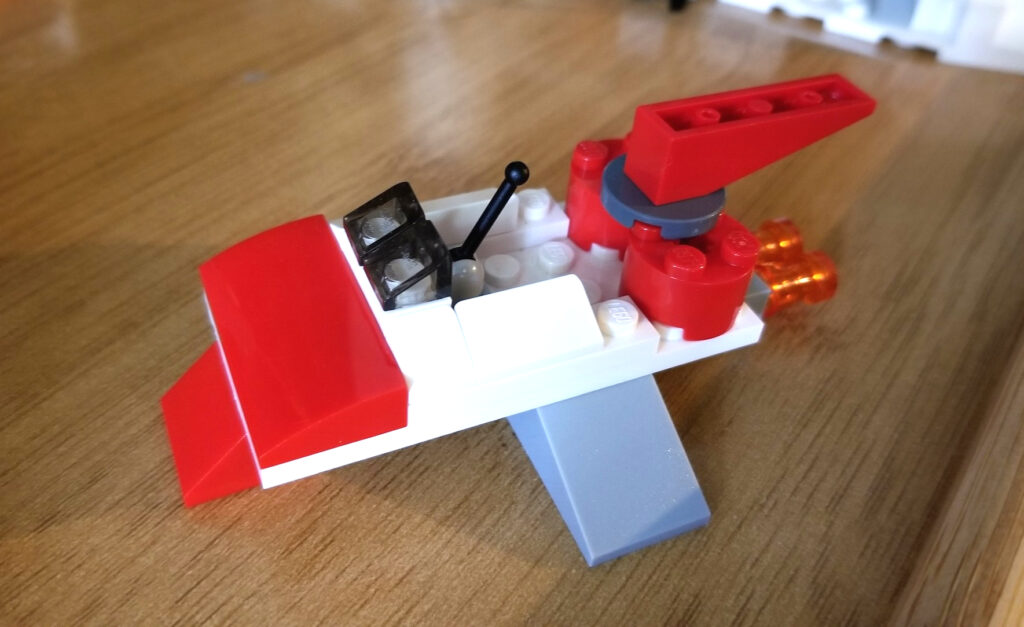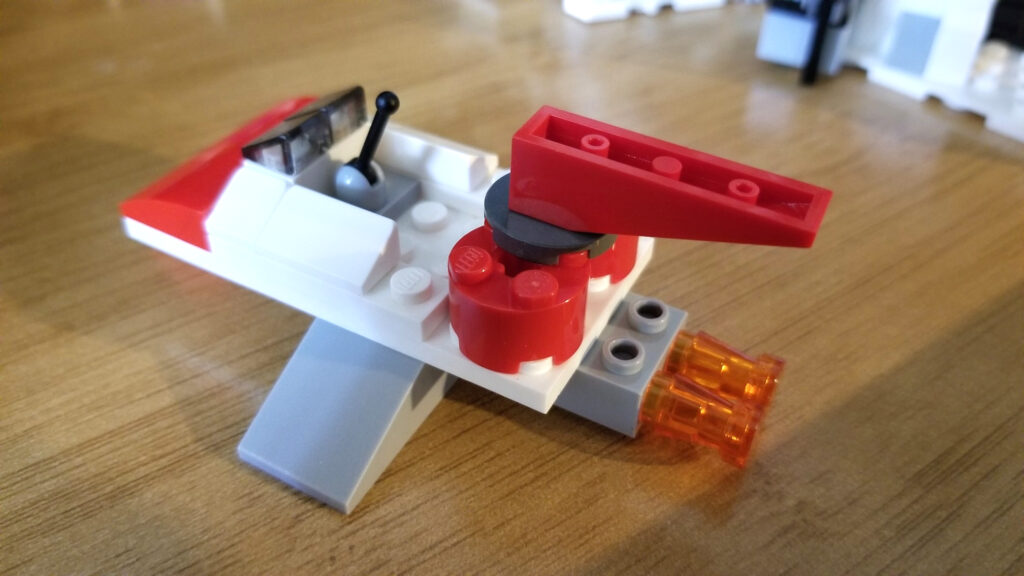
There’s a time in a parent’s life–I’m making a sweeping assumption here based on my own experience, but I’d bet money it’s accurate–that in raising their child(ren), they encounter not only toys that are particularly cool (with thoughts of, Man, I wish they had stuff this cool when I was a kid), but also revisit items they did have but that they had forgotten about in the decades since being a kid themselves.
So it is with me and Lego.
My daughter has an ebbing and flowing love of Lego, but when it flows, it flows hard. Attesting to that is the corner of our small house’s living room dedicated to Lego, complete with not only some craft tables covered in the stuff, and with more boxes of it underneath, but also with custom shelving above it that my wife designed and installed to display (/store) finished kits.
Ah… the kits.
Those are a bit of an issue for me.
Here’s the thing: I’m no purist about many things, but I’m finding I do… lean that way when it comes to Lego. This isn’t as much a “back in my day” rant about how things were better (although some things objectively were–where my Passion Flakie peeps at?), but to me, the whole point of Lego was a kind of “Here’s a bunch of cool shapes that connect together. Go use your imagination about what they could turn into” situation. Which led to very blocky cars and planes and rockets, etc., but that was all part of it: Not just how good an imitation you could make of what you were creating, but in using your imagination to help that hacky imitation be that thing regardless.
2D car with no wheels to speak of? Okay.
A really chunky airplane with rectangular wings and only a nod to a tail section? Sure.
A cubical rocket ship? Why not?
Then a couple of decades ago, Lego started coming out with licensed, pre-fab kits for specific pop culture phenomena. The lead-up to such releases was perhaps a long-time coming, with their increasing numbers of sets where This box contains all the parts to make this specific rocket launch pad, or This box is a scene in a city with a jail cell with a robber you can put inside and with a smiling police officer in a car driving by-type of arrangement.
But those remained Lego ideas. They were Lego people in Lego-contrived scenarios, and entire series dedicated to building up whole cities or space settings, and you could keep those sets together if you wanted to, but of course no one did for too long. (Again, that’s a generalization on my part, but while I’m not saying anyone who kept all of their Lego-devised sets together and never used those parts for anything else is an outlier, I am saying that authorities may want to do a little scanning below the basement floors of such peoples’ houses, because wow.)
The licensed properties, though… that’s a whole other ballgame.
Suddenly, instead of a mishmash of colours and blocks or even a set designed for a playful scene which you could play with or add to other sets, you had entirely customized pieces and characters to put together a specific scene or setting from blockbuster movies. You could get Star Wars kits to put together TIE fighters and X-wing fighters with stormtrooper or rebel pilots, and Indiana Jones (complete with whip in motion for him to hold) in the marketplace or in an Egyptian setting and, as my daughter has been going to town building recently, there’s anything and everything to do with Harry Potter available.
And whoo, lordy, this stuff ain’t cheap.
On the one hand, I get it: Lego wanted to increase interest in their mid-1900’s invention, so they got into popular intellectual properties outside their own domain to bump up sales. They have to pay the various rights holders a fee to make products in that world and with those characters, etc., and that’s surely no small sum. And of course traditionally, additional company costs get put onto the consumer.
That’s Economics 101.
Got it.
But the flipside to that is that people are now buying pre-fab kits that have very specific, unique parts for a very specific, unique setting or scene within these worlds, and are paying a lot for that privilege.
Never before had Lego struck me as a big ticket item, but these kits are up there.
My daughter really wanted the Hogwarts Express Lego kit, and was fully prepared to pay the entire cost of $100 for it herself.
It ended up being on a slight sale, and we split the cost of it with her, but I hope I’m not so out of the cool loop (that’s still a saying, right?) to believe that $100–for a set that will likely only be played with briefly, and pretty soon end up on a shelf and very rarely touched–is wildly overpriced.
Don’t get me wrong, all these kits are well made and offer impressive detail I wouldn’t have expected or considered–and the kid in me still wants to play with them, especially the Batman and Star Wars stuff–but to me the existence of such pre-fab kits goes to a large degree against the inventive, imaginative spirit that Lego was based on. The bulk of what they sell is no longer the box of hundreds of colourful pieces to make of it what you will, but rather a carefully curated collection of very specific pieces made to do this one thing with based on someone else’s imagination.
I mean, that’s of course the nature of decades of kajillions of toys ever since the original Star Wars action figures were released and the world woke up to this newfangled idea of merchandising movies and shows: There’s sometimes insane money to be made by companies selling the rights to popular IP to make action figures and accessories up the yinyang from those worlds.
But it seems to me that there’s a big trade-off here, of paying a premium to piece together something specific another person devised rather than paying less to have the freedom to make your own creations. And as mentioned, the Hogwarts Express will be played with but then very soon, I guarantee you, be put aside. The spirit of Lego used to be to make things your brain thinks up and then take them apart and make something else, again and again. Now it seems to be to assemble a thing created by someone else and then only display it soon after.
I mean, yes, you could take these kits apart and use them to cobble together whatever your imagination came up with from them. But I have a hunch that the Hogwarts Express, as just the latest example of more and more, is going to remain wholly intact and unplayed with inside a few weeks. It’ll sit on a shelf and need to be dusted every so often. It’s a $100 toy that will have brought perhaps a few days worth of hands-on playful enjoyment before being (literally) shelved indefinitely.
Meanwhile, a few days ago, my daughter invited me to play with her amid a pile of hundreds, maybe thousands, of Lego pieces of various shapes and colours that she had literally dumped onto the living room floor.
She went total old school with it.
I was there immediately and with some trial and error, cobbled together the space ship featured in this post, as well as a Segway (that stood up on its own, no less).
I put them together from a heap of random Lego, based on pieces I found and ideas they evoked, and let my imagination lead the way to create my own inventions.
Here’s hoping future generations never forget the fun of doing that.
